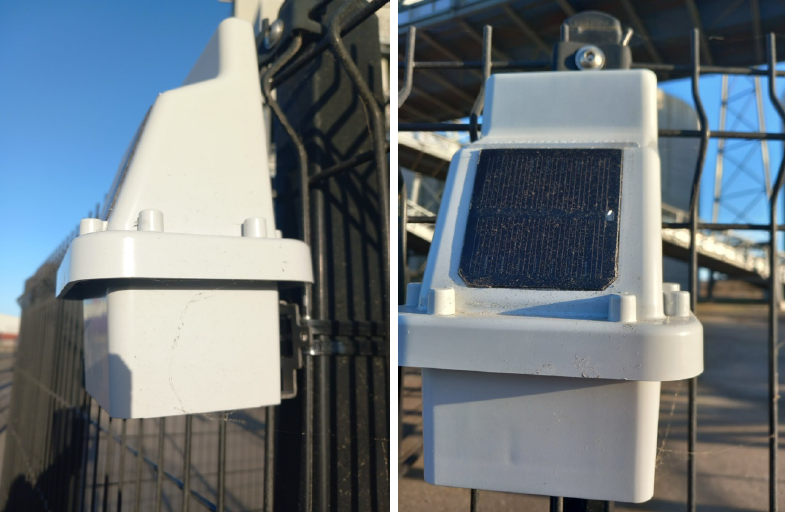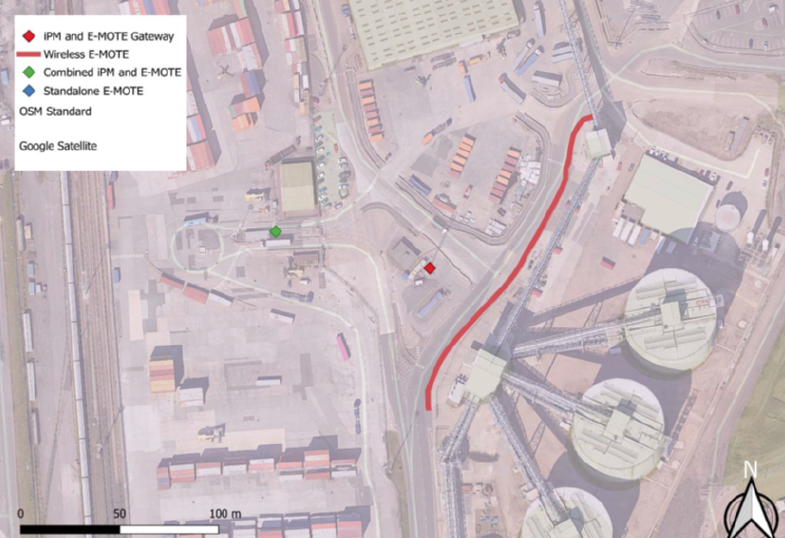Five Port of Tyne 5G network will enable the tracking of vehicles and the environment including PM1, PM2.5 and PM10 parFculate, Nitric Oxide, Nitrogen Dioxide, Carbon Monoxide to enable the port to understand how improvements in operations can posiF=tively impact the environment, vehicle utilisation and efficiency.
• 20 trackers fitted to operational vehicles
• 35 environmental sensors (PM, gas and noise) along operational routes
• Data integrated with digital twin

What is the problem to be solved?
There is an operational need and environmental imperative for the Port of Tyne to monitor and subsequently reduce emissions from vehicles operating on the Port estate. Reduced emissions could lead to cost savings for the Port and its customers and more efficient operations resulting in reduced fuel usage, reduced wear and tear on vehicles. The starting point for delivering this use case is to fit 5G-enabled environmental sensors to
vehicles operating within the Port. Data needs to be collected to better understand operations and the current environmental condition and how this can be used to make improvements.

What is the solution to the problem?
5G Network Expansion:
The network expansion was to provide private 5G coverage across International Passenger Terminal operating areas and connection back to existing 5G network, to enable Port assets to move between sites and continuously be connected to Port systems. This will also enable future location and operational specific use cases.
This infrastructure was delivered in partnership with Ericsson and has a backhaul connection to the Port’s existing private 5G network on the South side of the river. N77 radios and baseband provide the network coverage and there is a 10gbps backhaul link to connect the new kit to the existing core. In the short term, the new network will enable the infrastructure scanning use case which is based on AI and cloud processing of the images. Longer term, the North side network will support further use cases and development related to ferry and cruise operations which includes passengers, vehicles and RoRo freight.
Asset/Emission Monitoring – environmental use case
This use case involved the deployment a number of environmental sensors including PM1, PM2.5 and PM10 parFculate, Nitric Oxide, Nitrogen Dioxide and Carbon Monoxide gas, noise, temperature and humidity sensors as well as vehicle trackers. Data will be recorded in a cloud application and will integrate into the Port’s digital twin via available APIs.
The data will be used to provide insight into on-site operaFons and impact on the environment. Management will then make informed decisions on operational routes to improve environmental quality and operational efficiency.
All equipment delivered under this use case scope leveraged an existing air quality solution, however some development was required to enable devices to run directly on P5G and from a battery. The vehicle transponder was developed using off the shelf components but assembled specifically for this project. InstallaFon of the environmental sensors has been completed in two phases and installaFon of the vehicle trackers are in progress.
This use case was delivered in partnership with Envirowatch, a South Shields based business.


Commercial model (Business Case)
The business case for environmental monitoring rests on improving operational efficiency of the port and reducing environmental overall emissions.
The use case should deliver positive impact on environmental quality across the Port and improvements in operational vehicle movements which could lead to cost savings for the Port and its customers and more efficient operations resulting in reduced fuel usage, reduced wear and tear on vehicles.
The project supports the continued investment in advanced technology in maritime and related activities at the Port. The investment in 5G on the North side of the river will support future investment to upgrade passenger facilities at the International Passenger Terminal, delivering a better experience for visitors to the area, both UK and International.
The use cases have supported confidence to invest in related technology projects, using the benefits of 5G technology to support planning of automation projects, the use of autonomous vehicles, and improved service for customers. These projects will come forward for assessment over the next 12 – 24 months. We are expecting that investment in these projects will be in the region of £2m - £5m over the coming two years.
Future capital will probably be funded from the Port’s borrowing facilities.
Benefits
Environmental improvements & operational efficiency: The benefits we are expecting from this use case is a more positive impact on environmental quality across the Port and improvements in operational vehicle movements which could lead to cost savings for the Port and its customers and more efficient operations resulting in reduced fuel usage, reduced wear and tear on vehicles. Further data needs to be collected to better understand operations and the current environmental condition and how this can be used to make improvements.
Lessons Learnt
- Do: Where procurement of subcontractors and contractors is involved, pre-emptive drafting of
procurement specifications is beneficial to timely project progression - Do: Early discussions around resource requirements would have improved processes and
shorten timescales - Do: Commence process of supplier induction early to ensure approvals are in place in time to
carry out onsite work - Do: 5G network planning - review proposed locations of radio masts alongside ducting maps to
ensure appropriate connectivity to utilities - Do: All parties needed to work together and build in additional time to work through the
interoperability issues, as there have been challenges connecting agreed devices to the private
network. - Do: Explore opportunities to collaborate with wider sectors and other companies within the
supply chain i.e. Plant & equipment OEMs looking to innovate on 5G networks - Don’t: Underestimate the time and complexity to installing or upgrading a 5G network. 5G
network upgrade can take longer than initially anticipated - Don’t: Underestimate the complexity of matching device technology to appropriate vehicles,
which has presented problems requiring vehicle substitution/modification and network
upgrade
If you’re ready to embark on a connectivity project, we can point you to the suppliers with expertise in your sector.
